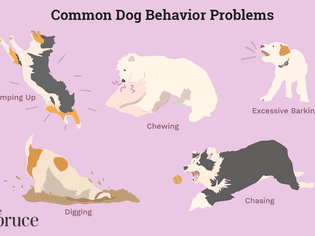10 Common Dog Behavior Problems and Solutions
Dog behavior problems are often misunderstood or mishandled by dog owners. Perhaps you are new to dog ownership, considering getting a dog, or just wi

Dogs bark for many reasons: to express how they’re feeling, to communicate crucial information, and to draw attention to something they find concerning. In addition to facial expressions, body language, and other vocalizations, barking is a vital way for dogs to communicate. People often find a barking dog annoying, but it’s important to remember that from the dog’s perspective, they are trying to convey necessary information.
Dogs should not be punished or yelled at for barking. Instead, if barking is causing issues for the people around them, understanding why a dog is barking can go a long way in addressing the issue and finding positive training techniques to help resolve it.
Like their wild relatives, domestic dogs have a large variety of vocalizations to help them communicate, and they have fine-tuned how to use these sounds with humans over time. Studies of dogs and wild canids like wolves and foxes have shown that dogs not only tend to vocalize more when they are around humans, but that they’ve also evolved unique forms of verbal communication.
Dogs are experts at reading human responses and can adjust their vocalizations to impart specific information to people about their desires and emotional states. And people have learned to understand these verbal cues from dogs—in studies where people listened to recordings of dogs barking in various situations, they were able to accurately determine the emotional state of the dogs.
Barking is one of the most recognizable and frequently used vocalizations in dogs (others include whining and growling). A dog’s bark is unique depending on breed and individual variation. Breeds like the shar-pei, chow chow, and basenji tend to bark less than other dogs, while hounds have very recognizable barks that are distinctive to their breed, even though individual dogs’ barks may vary.
A dog will bark to alert you to something in the environment, like a package delivery or someone approaching the door, when they want to play, when they’re bored or anxious, as a greeting, when they’re afraid, or when they want to go outside or come in. They may bark to show they’re excited about something, like a walk or a car ride.
Some dogs bark to express uncertainty when they encounter something new or when they want attention. Dogs may also bark at something they can see, smell, or hear that you cannot. When you live with a dog, you can learn to recognize what their various barks mean and how to better meet their needs.
While dogs are uniquely adapted to living with humans and have developed strategies to effectively “talk” to their people, sometimes these methods of communication break down. Often, the dog is trying to tell you something, but the message is not getting across or is not being understood. In these cases, dogs’ barking can be labeled as “excessive” or “unnecessary,” when in fact, from the dog’s perspective, it is quite necessary.
For example, if a dog left alone in a yard all day barks nonstop, this may be a sign that the dog is bored and lonely, and the situation needs to be modified to improve the dog’s wellbeing. Other causes of barking in dogs include:
If your dog has had a change in behavior and is barking more than usual, barking at abnormal times and in inappropriate situations, or the sound of your dog’s bark has changed, then first take your dog to a veterinarian to rule out any underlying medical causes. If there are no underlying physical causes, you can also talk to your veterinarian about ways to deal with barking, as long as any methods suggested are force-free and do not punish or create negative experiences for the dog.
You should never try to “stop” barking in dogs because it’s a key part of their ability to communicate. If a dog is not permitted to bark, this results in frustration and compromises your dog’s happiness and welfare. Rather, if your dog’s barking is causing an issue, either for you, other family members, or neighbors, follow these steps to try to help your dog bark less in certain situations.
Never use the following:
These techniques use punishment to create a negative association between the unwanted behavior (barking) and an unpleasant or painful response from you. There are many problems with these techniques including creating fear and possibly aggression in your dog and eroding the bond between you and your dog, leading to your dog not trusting you. Often, these techniques do not actually resolve the problem since your dog learns to avoid doing the behavior in your presence but is not actually learning what to do instead.
Barking from fear or anxiety, including separation anxiety, may require veterinary treatment to address the underlying problem. It can be very helpful to work with a professional trainer if you are struggling to change your dog's barking behaviors, but make sure they use only positive reinforcement and force-free training methods. Never use a trainer that punishes or causes pain or fear in your dog.

Dog behavior problems are often misunderstood or mishandled by dog owners. Perhaps you are new to dog ownership, considering getting a dog, or just wi

Signs of jealousy can occur in dogs in many different situations. They may arise between dogs in multi-dog households or when your pup has a visiting

Training your dog to go to its place can be helpful when you need it to settle down or get out from under your feet. You can pick one place in your ho

There are a number of reasons to crate train your dog. Most puppies and adult dogs feel more secure in a small, enclosed den-like area, and young pupp

Breakfast is the most important meal of the day, and eggs are a cheap, nutritious staple to help you get going in the morning. But when Fido starts ga

Cranberries are rich in nutrients and antioxidants that have been touted as playing a role in everything from boosting your immune system to decreasin
We are an information hub dedicated to delivering clear, trustworthy, and engaging content across a wide spectrum of topics — from innovation and trends to daily life, wellness, and global developments.
Our team is passionate about creating content that helps people stay curious, make informed decisions, and understand the world with greater clarity and context.
With a focus on quality, relevance, and accessibility, we aim to offer a meaningful experience for everyone seeking knowledge, ideas, and thoughtful perspectives.